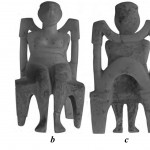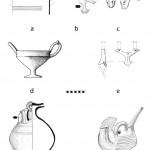MYCENIEN PA-WE-A PE-NE-WE-TA /PHARWEHA PHERNEWWENTA/ : DES TEXTILES AVEC DES PIECES RAPPORTEES
ALAIN BLANC
The Mycenaean neuter plural pe-ne-we-ta qualifies articles of clothing (pa-we-a /pharweha/), or it is used near the logogram TELA. There have been several proposals: /pnewent-/ ‘vaporosi’ (Gallavotti), /pneuwent/- ‘ariosi’ (Doria), /pen-went-/ or /penewent-/ (Chadwick : pen- from πίνος ‘natural grease in wool’), or even /sphēn-went-/ ‘featuring a weave with wedges’ (σφήν), but none of these explanations is suitable (cf. DMic. II, 99). We try to show that pe-ne-we-ta can conceal /phernewwenta/ ‘provided with /phernes-/’. This adjective in *-u̯ent- is built on a neuter noun with the suffix *-nes-/-nos (cf. ἔρνος, τέμενος, etc.) from the root *bhér- ‘bear’. The form with the suffix *-neh2, φερνή ‘dowry’, indicates what the bride ‘brings’ to the new family; the form with the suffix *-nes- is a technical term which indicates ‘what is borne’ on an article of clothing, probably a decoration sewn on the fabric, vel sim. The neuter noun, which would have been *φέρνος, genitive *φέρνεhος, was not preserved in the first millennium, but it has a correspondent in the second member of the Vedic compound sahásra-bharṇas- ‘with a thousand gifts’.

Blanc A., Mycenien pa-we-a pe-ne-we-ta /pharweha phernewwenta/ : des textiles avec des pieces rapportees, SMEA NS 10, 2024, 9-20.


